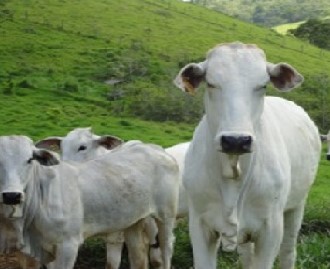Supplementation of grazing heifers with different protein sources
Suplementación de novillas en pastoreo empleando diferentes fuentes de proteína.

Show authors biography
Objective. Evaluate the effects of supplementation with different protein sources (soybean meal and wheat bran with urea) on the productive performance, intake, digestibility, microbial protein synthesis, and metabolic profile of grazing beef heifers. Materials and methods. Were used twenty Nellore heifers at 8.5±0.06 months of age, with an initial average body weight of 241.5±4.71 kg. The animals were distributed in a completely randomized deseing with two treatments and ten replicates. Two protein sources in the supplements were evaluated: 1) Soybean meal (SBM), and 2) Soybean meal + Wheat bran + Urea (SBM+WB+U). Results. Crude protein (CP) and organic matter intakes were higher (p<0.05) for heifers from SBM compared with SBM+WB+U. The CP digestibility was increased (p<0.05) with SBM supplementation. Mean blood concentrations of glucose, cholesterol, serum urea nitrogen, and total proteins were not affected (p>0.10) by protein sources. In the same way, daily weight gain and final body weight were not influenced (p>0.10) by protein sources. Conclusions. The supplementation with soybean meal or wheat bran with urea in association with soybean meal in multiple supplements for grazing cattle provides similar productive and nutritional performance and metabolic profile in beef heifers.
Article visits 1262 | PDF visits
Downloads
- USP-MADR. Precio por litro de leche pagado al productor a nivel nacional y regional. Unidad de Segumiento de Precios de la Leche. Ministerio de Agricultura y Desarrollo Rural: Colombia; 2020. http://uspleche.minagricultura.gov.co/precio-pagado-al-proveedor-con-bonificaciones-voluntarias-nacional-y-regional.html
- Restrepo-Betancur LF, Peña-Serna C, Zapata-López N, Restrepo-Betancur LF. Disponibilidad de Leche de los Países Sudamericanos en las Últimas Cinco Décadas: Elementos para Análisis y Perspectivas Futuras. Inf tecnol. 2019; 30(4):77–84. http://hdl.handle.net/10495/12387
- Gaona RC, Terranova MV, Hernández E, Alegría KG, Benavides RM, Guerrero HS, et al. Genetic improvement in dairy cows. The essence of true animal production. Acta Agron. 2016; 64(3):296–306. https://revistas.unal.edu.co/index.php/acta_agronomica/article/view/50263/56012
- Vásquez JF, Loaiza ET, Olivera M. Calidad higiénica y sanitaria de leche cruda acopiada en diferentes regiones colombianas. Orinoquia 2012; 16(2):13. https://orinoquia.unillanos.edu.co/index.php/orinoquia/rt/printerFriendly/251/737
- Decreto 616. Por el cual se expide el Reglamento Técnico sobre los requisitos que debe cumplir la leche para el consumo humano. Ministerio de la Protección Social: Colombia; 2006. https://www.ica.gov.co/getattachment/15425e0f-81fb-4111-b215-63e61e9e9130/2006D616.aspx
- Martínez M, Gómez C. Calidad composicional e higiénica de la leche cruda recibida en industrias lácteas de Sucre, Colombia. Biotecnología En El Sector Agropecuario Y Agroindustrial. 2013; 11(2):93-100. https://revistas.unicauca.edu.co/index.php/biotecnologia/article/view/309
- Rodríguez RV, Calderón RA, Vergara GO. Calidad de leches crudas en tres empresas acopiadoras en Córdoba. Rev Colomb Cienc Anim RECIA. 2014; 6(1):103–15. https://doi.org/10.24188/recia.v6.n1.2014.222
- D’Amico DJ, Donnelly CW. Microbiological quality of raw milk used for small-scale artisan cheese production in Vermont: Effect of farm characteristics and practices. J Dairy Sci. 2010; 93(1):134-147. https://doi.org/10.3168/jds.2009-2426
- Smigic N, Djekic I, Tomasevic I, Miocinovic J, Gvozdenovic R. Implication of food safety measures on microbiological quality of raw and pasteurized milk. Food Control. 2012;25(2):728–31. https://doi.org/10.1016/j.foodcont.2011.12.022
- Resolución 017. Por el cual se establece el sistema de pago de leche cruda al proveedor. Ministerio de Agricultura y Desarrollo Rural: Colombia; 2012. [Consultado octubre de 2019]. https://www.icbf.gov.co/cargues/avance/docs/resolucion_minagricultura_0017_2012.htm
- Resolución 468. Por la cual se modifica la resolución 017 de 2012, modificada por la resolución 077 de 2015. Ministerio de Agricultura y Desarrollo Rural: Colombia; 2015. [Consultado octubre de 2019]. https://www.icbf.gov.co/cargues/avance/docs/resolucion_minagricultura_0468_2015.htm
- Norma técnica NTC-ISO/IEC Colombiana 17025. Requisitos generales para la competencia de los laboratorios de ensayo y calibración. Instituto Colombiano de Normas Técnicas (ICONTEC): Colombia; 2005. [Consultado diciembre 2019]. https://www.invima.gov.co/images/pdf/red-nal-laboratorios/resoluciones/NTC-ISO-IEC_17025-2005.pdf
- Organismo Nacional de Acreditación – ONAC. Directorio de laboratorios acreditados: Colombia; 2020 [Consultado 10 de agosto 2020]. https://onac.org.co/directorio-de-acreditados
- Koenker R. Quantile regression. New York. Cambridge University Press. 2005. https://books.google.com.co/books?id=hdkt7V4NXsgC&printsec=frontcover&hl=es&source=gbs_ge_summary_r&cad=0#v=onepage&q&f=false
- Lambertz C, Sanker C, Gauly M. Climatic effects on milk production traits and somatic cell score in lactating Holstein-Friesian cows in different housing systems. J Dairy Sci. 2014;97(1):319–329. http://dx.doi.org/10.3168/jds.2013-7217
- Hoye A. Recommend or mandate? A systematic review and meta-analysis of the effects of mandatory bicycle helmet legislation. Accid Anal Prev. 2018; 120:239–249. https://doi.org/10.1016/j.aap.2018.08.001
- Papademas P, Bintsis T. Food safety management systems (FSMS) in the dairy industry: A review. Int J Dairy Technol. 2010; 63(4):489–503. http://dx.doi.org/10.1111/j.1471-0307.2010.00620.x
- Calderón A, Rodríguez V, Arrieta G, Martínez N, Vergara O. Calidad fisicoquímica y microbiológica de leches crudas en empresas ganaderas del sistema doble propósito en Montería (Córdoba), Rev UDCA Act & Div Cient. 2012; 15(2):399–407. https://revistas.udca.edu.co/index.php/ruadc/article/view/841
- Khodabocus F, Balgobin K. Implementation and Practical Benefits of ISO/IEC 17025:2005 in a Testing Laboratory. Univ Mauritius Res J. 2011;17(1):27–60. http://dx.doi.org/10.4314/umrj.v17i1.70730
- Duarte V. J, Ramírez Z. G, Castañeda S. R. Grasa sobrepasante: Aplicaciones y su proceso de obtención para la alimentación de rumiantes en el trópico. Rev Colomb Cienc Anim - RECIA. 2016; 8(2):228. https://doi.org/10.24188/recia.v8.n2.2016.192
- García C, Montiel R, Borderas Y. Grasa y proteína de la leche de vaca: componentes, síntesis y modificación. Arch Zootec. 2014; 63:85-105. https://doi.org/10.21071/az.v63i241.592
- Arrieta B, Gomezcaceres P, Albis F, Calderón-Rangel A, Rodríguez R. Calidad de la leche cruda para consumo humano en dos localidades de Sucre (Colombia). Rev MVZ Córdoba 2019; 24(3):7355–7361. https://doi.org/10.21897/rmvz.1829
- Hill DL, Wall E. Dairy cattle in a temperate climate: The effects of weather on milk yield and composition depend on management. Animal. 2014; 9(1):138–149. http://dx.doi.org/10.1017/S1751731114002456
- Rodríguez-Rodríguez V, Acosta-Ruiz A. Calidad de leches crudas en sistemas doble propósito en Córdoba (Colombia), en condiciones de máxima y mínima precipitación. Rev Vet Zootec. 2014; 8(2):72-86. http://190.15.17.25/vetzootec/index.php/component/content/article?id=104
- Escoto FC, Vargas AC, Oño IM. La calidad estándar de la leche en el estado de Hidalgo, México. Rev Mex Cienc Pecu. 2013;4(1):82. https://cienciaspecuarias.inifap.gob.mx/index.php/Pecuarias/article/view/2827
- Oliszewski R, Cisint J, Medina CF. Caracterización composicional, fisicoquímica y microbiológica de leche de vaca de la cuenca de Trancas. COCINET. 2016; 36(4105):31–9. https://www.conicet.gov.ar/new_scp/detalle.php?keywords=&id=31611&articulos=yes&detalles=yes&art_id=6712611























